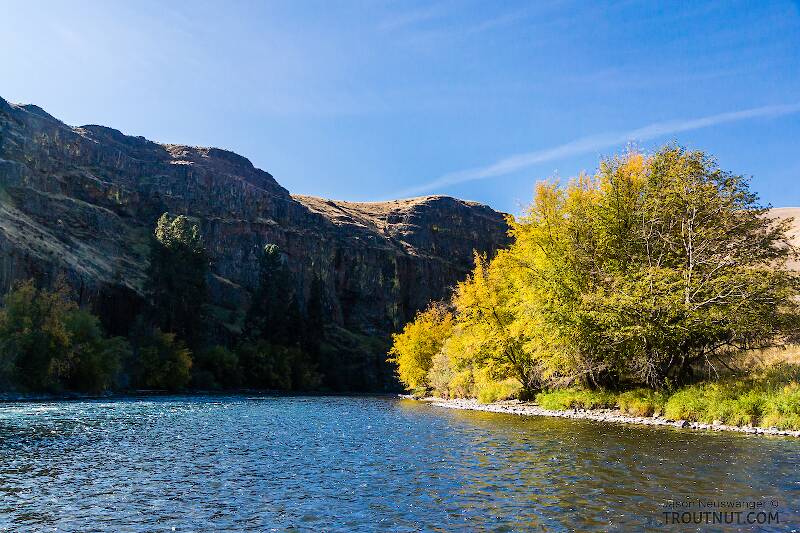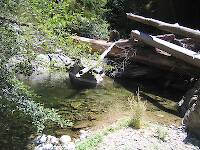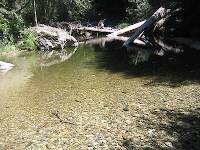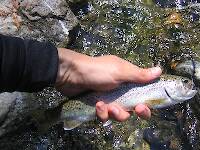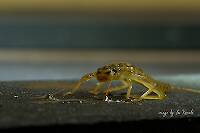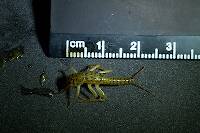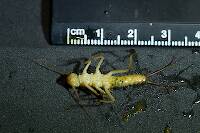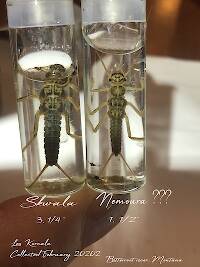
Salmonflies
Pteronarcys californica
The giant Salmonflies of the Western mountains are legendary for their proclivity to elicit consistent dry-fly action and ferocious strikes.
Featured on the forum

This dun emerged from a mature nymph on my desk. Unfortunately its wings didn't perfectly dry out.

Troutnut is a project started in 2003 by salmonid ecologist Jason "Troutnut" Neuswanger to help anglers and
fly tyers unabashedly embrace the entomological side of the sport. Learn more about Troutnut or
support the project for an enhanced experience here.
Martinlf on Feb 4, 2020February 4th, 2020, 11:14 am EST
John, also see Dom's Troutbitten website. I hope Jason won't mind me linking it here. He has a long leader design that I'm trying out next season:
https://troutbitten.com/2019/10/13/the-full-mono-rig-system-all-the-variations-with-formulas-and-adjustments/
Dom's not focused on specific bugs, but has lots of good practical tips on fishing. I went out with him last spring, and enjoyed a bit of tutoring. I read his tips regularly.
https://troutbitten.com/2019/10/13/the-full-mono-rig-system-all-the-variations-with-formulas-and-adjustments/
Dom's not focused on specific bugs, but has lots of good practical tips on fishing. I went out with him last spring, and enjoyed a bit of tutoring. I read his tips regularly.
"He spread them a yard and a half. 'And every one that got away is this big.'"
--Fred Chappell
--Fred Chappell
Wiflyfisher on Feb 4, 2020February 4th, 2020, 11:46 am EST
Thanks! I have been on his website. I will make several mono leaders to test with my Hardy 10 ft 4wt fly rod.
BTW, I may be going West in mid-June.
BTW, I may be going West in mid-June.
John S.
https://WiFlyFisher.com
https://WiFlyFisher.com
Martinlf on Feb 4, 2020February 4th, 2020, 12:47 pm EST
Sounds good, John. If you are in Montana on June 24, and in the vicinity of the North Fork of the Blackfoot, I'm thinking of hiking up from the trailhead to fish the canyon, and I'd enjoy the company. The next week after that I'll be fishing with folks on the Missouri, but I plan to wade fish Rock Creek on July 2 by myself, and you'd be welcome. I'll be at Wolf Creek until July 1.
"He spread them a yard and a half. 'And every one that got away is this big.'"
--Fred Chappell
--Fred Chappell
Troutnut on Sep 7, 2020September 7th, 2020, 8:44 am EDT
Louis and Matt, have you been testing out Euro nymphing as planned this year? I'm just getting into it, too. I pooled some gift checks last winter to buy a Syndicate P2 Pipeline Pro rod (10' 3-weight) with a reel and line suitable for Euro nymphing. I've also read and highlighted large swaths of Devin Olson's book "Tactical Fly Fishing," which I found to be the best fly fishing instructional books I've seen in a long time. It has some useful insights for any angler, but most of the book is a detailed intro to Euro nymphing. He has a very analytical approach to breaking down every detail of the techniques and justifying his recommendations, and it just perfectly fits my style of learning and trying to improve my fishing.
However, on my main fishing trip this summer around Yellowstone and Idaho, I didn't have many opportunities to try it (or I wasn't looking too hard). I was in more dry fly and streamer situations. I definitely could have used it a few times when I backpacked up Slough Creek, but I was already packing two rods and three seemed excessive.
I just returned from another trip on which I finally got to give it a proper try on some water suited to the technique, and I was really impressed. I still have a lot to learn about it, but I caught several nice trout I probably wouldn't have caught otherwise. I also caught the heck out of whitefish, which suggests I was getting my nymphs down to the bottom more effectively than I usually have in the past.
I think it's going to become my go-to method for most nymphing situations, at least when I have the opportunity to carry multiple rods. When I'm just fishing several miles of stream for the day with a single rod, which I do fairly often, I'll probably stick with my conventional rig, although I know there are ways to adapt the Euro system for dries and I might try to figure that out.
However, on my main fishing trip this summer around Yellowstone and Idaho, I didn't have many opportunities to try it (or I wasn't looking too hard). I was in more dry fly and streamer situations. I definitely could have used it a few times when I backpacked up Slough Creek, but I was already packing two rods and three seemed excessive.
I just returned from another trip on which I finally got to give it a proper try on some water suited to the technique, and I was really impressed. I still have a lot to learn about it, but I caught several nice trout I probably wouldn't have caught otherwise. I also caught the heck out of whitefish, which suggests I was getting my nymphs down to the bottom more effectively than I usually have in the past.
I think it's going to become my go-to method for most nymphing situations, at least when I have the opportunity to carry multiple rods. When I'm just fishing several miles of stream for the day with a single rod, which I do fairly often, I'll probably stick with my conventional rig, although I know there are ways to adapt the Euro system for dries and I might try to figure that out.
Jason Neuswanger, Ph.D.
Troutnut and salmonid ecologist
Troutnut and salmonid ecologist
Martinlf on Sep 8, 2020September 8th, 2020, 2:19 pm EDT
Jason, I've actually been Euro Nymphing for about nine years, having taken a lesson with George Daniels in 2011. I use three rods mainly, a 10' 4W Cabela's CZN, a 10' 3W Echo Shadow, a TFO 3W drift rod that can be configured in 9', 10', 11'3" and 12'3" lengths. I love the Echo rod, and will start with it unless I anticipate big fish. On Penns I'll use the Cabela's rod. I use the TFO rod when I'm dry fly fishing and may need to nymph; the 1' extension fits easily in my waders and the conversion can be made without removing the reel--though I typically do. I haven't tried the 11'3" for nymphing, but did try some trout spey with it. It's a lot of fun to play around with, and not too expensive. You might give it a try for those days you just want to carry one rod. That's why I got it.
One of my favorite places to get information about nymphing is Dom's Troutbitten website. He also regularly emails articles out if you get on his list. I fished with him about a year ago, and he's smart and flexible. I've heard good things about Olson, and will pick up his book. I like George Daniels' books too. Although I almost always use weighted flies and try to avoid split shot, I've gone back to using split shot a bit more, especially in low clear water fishing scud patterns etc.. I rediscovered scuds this summer in some low clear conditions and they worked exceptionally well on some pressured streams.
Dom stresses the need to adapt, and has lots of articles about different approaches for different conditions. I used mono rigs (really long leaders, with no fly line in play) a few times last year and this, and a couple of days last fall in very low clear water it really paid off. Something else to try.
I've fished dries on the 10' rods when I had to, and it can work. My typical leader for euro nymphing is a 9' 0X plus sighter and tippet as per George Daniels' recommendation. He's dropped to recommending 3x recently, but I am sticking with the OX for now. You can easily cast a dry with it adding the right tippet. Or you can remove the sighter and throw streamers. I've caught fish on dries using a mono rig, but it is tough to cast.
One of my favorite places to get information about nymphing is Dom's Troutbitten website. He also regularly emails articles out if you get on his list. I fished with him about a year ago, and he's smart and flexible. I've heard good things about Olson, and will pick up his book. I like George Daniels' books too. Although I almost always use weighted flies and try to avoid split shot, I've gone back to using split shot a bit more, especially in low clear water fishing scud patterns etc.. I rediscovered scuds this summer in some low clear conditions and they worked exceptionally well on some pressured streams.
Dom stresses the need to adapt, and has lots of articles about different approaches for different conditions. I used mono rigs (really long leaders, with no fly line in play) a few times last year and this, and a couple of days last fall in very low clear water it really paid off. Something else to try.
I've fished dries on the 10' rods when I had to, and it can work. My typical leader for euro nymphing is a 9' 0X plus sighter and tippet as per George Daniels' recommendation. He's dropped to recommending 3x recently, but I am sticking with the OX for now. You can easily cast a dry with it adding the right tippet. Or you can remove the sighter and throw streamers. I've caught fish on dries using a mono rig, but it is tough to cast.
"He spread them a yard and a half. 'And every one that got away is this big.'"
--Fred Chappell
--Fred Chappell
Troutnut on Sep 8, 2020September 8th, 2020, 6:15 pm EDT
Ah, good to know you've been at it for a while. I've just started reading one of George Daniels' books too. Thanks for the recommendation on the Troutbitten site. Looks like some great reading there.
I wish Gonzo were still hanging around the forum. I'd love to get his take on some of these recent trends, like the move away from imitative nymphs to attractors fished with more efficient presentation, or a lot of the new tying materials. A lot of the patterns in his book tied with things like flexament-coated thread and Tyvek wingcases could probably be done more easily (and maybe more effectively) with some new synthetic materials, and I'm really curious if he's played around with those.
I wish Gonzo were still hanging around the forum. I'd love to get his take on some of these recent trends, like the move away from imitative nymphs to attractors fished with more efficient presentation, or a lot of the new tying materials. A lot of the patterns in his book tied with things like flexament-coated thread and Tyvek wingcases could probably be done more easily (and maybe more effectively) with some new synthetic materials, and I'm really curious if he's played around with those.
Jason Neuswanger, Ph.D.
Troutnut and salmonid ecologist
Troutnut and salmonid ecologist
Wiflyfisher on Sep 9, 2020September 9th, 2020, 1:10 am EDT
I tried Euro-nymphing in the early Spring with my 10ft 4wt fly rod. I knew there were a lot of net-spinning caddis larva in the river. The trout were definitely on the look out for the caddis larva in the drift near the bottom.
i find the Virtual Nymph Skin (3mm) makes very effective caddis larva bodies and the patterns sink fast.

The Euro nymphing was effective, but takes a lot of getting used too. After early Spring was over I put the reel with all mono away.
I didn't have the rod / reel for euro-nymphing with me out West, or I would have tried it on the Madison.
i find the Virtual Nymph Skin (3mm) makes very effective caddis larva bodies and the patterns sink fast.

The Euro nymphing was effective, but takes a lot of getting used too. After early Spring was over I put the reel with all mono away.
I didn't have the rod / reel for euro-nymphing with me out West, or I would have tried it on the Madison.
John S.
https://WiFlyFisher.com
https://WiFlyFisher.com
Troutnut on Sep 9, 2020September 9th, 2020, 3:19 am EDT
I'd love to try it on John's home water in WI, especially from March through May or so. I've caught some good fish indicator nymphing there early in the season under conditions that would have been ideal for Euro nymphing. I bet a fast-sinking Taeniopteryx stonefly imitation with a Hendrickson-nymph-themed perdigon would work great in March.
I'd guess the Madison would also be a great place for it. So would Rock Creek, MT. I first gave it a proper try on the Grey's River in WY, which is as close to a doppelganger for Rock Creek as I've ever seen, although it doesn't have the same trout species/subspecies.
I'd guess the Madison would also be a great place for it. So would Rock Creek, MT. I first gave it a proper try on the Grey's River in WY, which is as close to a doppelganger for Rock Creek as I've ever seen, although it doesn't have the same trout species/subspecies.
Jason Neuswanger, Ph.D.
Troutnut and salmonid ecologist
Troutnut and salmonid ecologist
Wiflyfisher on Sep 9, 2020September 9th, 2020, 11:51 am EDT
Jason, from your above comments you will enjoy this video I took... https://www.youtube.com/watch?v=y8lCQqXEJKw
BTW, back when they stocked my home waters, we had a ritual of keeping two rainbows / browns on opening day to eat that night. We never kept another trout all year. They always had E. subvaria nymphs and chartreuse caddis larva in their stomachs. In March / April there are always the Early Black stoneflies followed by the Early Brown Stoneflies. All the above aquatic insects are perfect for Euro nymphing. After that I switch. :-)
BTW, back when they stocked my home waters, we had a ritual of keeping two rainbows / browns on opening day to eat that night. We never kept another trout all year. They always had E. subvaria nymphs and chartreuse caddis larva in their stomachs. In March / April there are always the Early Black stoneflies followed by the Early Brown Stoneflies. All the above aquatic insects are perfect for Euro nymphing. After that I switch. :-)
John S.
https://WiFlyFisher.com
https://WiFlyFisher.com
Martinlf on Sep 9, 2020September 9th, 2020, 1:01 pm EDT
Jason, I wish Gonzo were back too. I know a member who isn't around anymore bothered him some back when. Perhaps you could get him to return; he always spoke highly of you. Thanks again for the tip on Olson's book; I just ordered it.
"He spread them a yard and a half. 'And every one that got away is this big.'"
--Fred Chappell
--Fred Chappell
Troutnut on Sep 14, 2020September 14th, 2020, 7:29 am EDT
Nice stonefly video John! I did pretty well imitating those nymphs when that was happening on that river, years earlier.
Jason Neuswanger, Ph.D.
Troutnut and salmonid ecologist
Troutnut and salmonid ecologist
Quick Reply
Related Discussions
Topic
Replies
Last Reply
2
Feb 24, 2020
by Leskorcala
by Leskorcala

